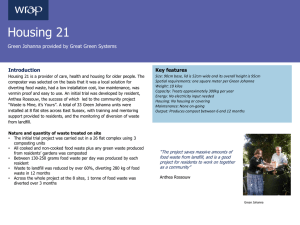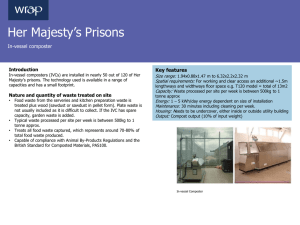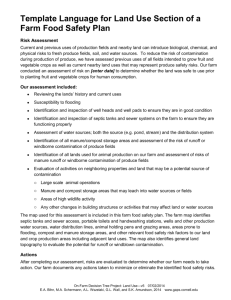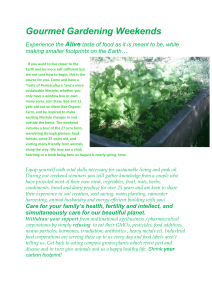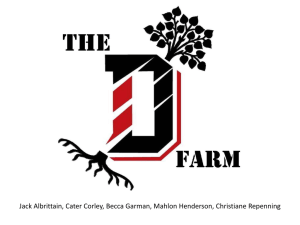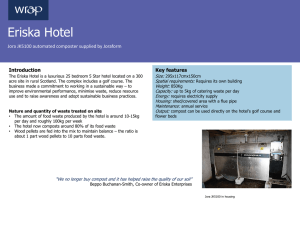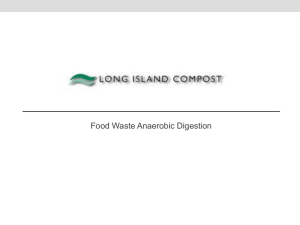Millets farm case study
advertisement
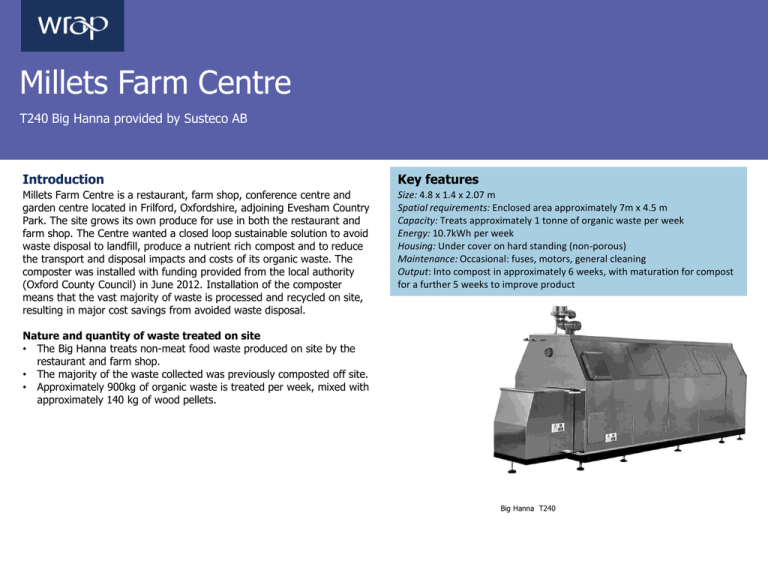
Millets Farm Centre T240 Big Hanna provided by Susteco AB Introduction Key features Millets Farm Centre is a restaurant, farm shop, conference centre and garden centre located in Frilford, Oxfordshire, adjoining Evesham Country Park. The site grows its own produce for use in both the restaurant and farm shop. The Centre wanted a closed loop sustainable solution to avoid waste disposal to landfill, produce a nutrient rich compost and to reduce the transport and disposal impacts and costs of its organic waste. The composter was installed with funding provided from the local authority (Oxford County Council) in June 2012. Installation of the composter means that the vast majority of waste is processed and recycled on site, resulting in major cost savings from avoided waste disposal. Size: 4.8 x 1.4 x 2.07 m Spatial requirements: Enclosed area approximately 7m x 4.5 m Capacity: Treats approximately 1 tonne of organic waste per week Energy: 10.7kWh per week Housing: Under cover on hard standing (non-porous) Maintenance: Occasional: fuses, motors, general cleaning Output: Into compost in approximately 6 weeks, with maturation for compost for a further 5 weeks to improve product Nature and quantity of waste treated on site • The Big Hanna treats non-meat food waste produced on site by the restaurant and farm shop. • The majority of the waste collected was previously composted off site. • Approximately 900kg of organic waste is treated per week, mixed with approximately 140 kg of wood pellets. Big Hanna T240 Millets Farm Centre: Big Hanna T240 Lessons Learnt Waste inputs need to be of a relatively consistent composition and closely monitored. During early operations all staff had access to the unit meaning too much food waste was added and the mixture turned ‘wet’. This was rectified in 2-3 days by removing material from the central chamber and adding wood pellets to alter the waste consistency. Some feedstock with tough parts (e.g. melons, potatoes, lemons) may require processing twice through the vessel to fully break down. The farm centre has experienced many additional benefits such as enhancing its reputation as a sustainable, innovative, and eco-friendly operation, and plans to promote the use of technology with a dedicated mural on the composter building. How food is separated for treatment Food waste is collected back of house by staff and presented outside the composting building. Food waste was always collected separately so no new bin arrangements were required. No extra staff resources are required as food separation and collection fits easily with the existing responsibilities of staff. How the on-site treatment system is managed Approximately one hour each day is necessary to run the composter. One staff member is currently responsible for this. The waste is mixed with a small quantity of wood chips to help improve the thermal efficiency of the process and to provide the appropriate structure/dry the process feed mixture. The mixed material is added to the Big Hanna on a daily basis and within 6 weeks is turned into a ready to use compost. External assistance is available from Susteco AB, if required, and initial training is provided for the operators. The ‘back-end’ of the process involves manually transferring the compost to heaps for further maturation for approximately 5 weeks. The final compost product is used on flower beds across the estate. No significant health and safety concerns have arisen. Use of outputs from treatment The compost is used on the farm centre grounds and flower beds. Costs The cost of the composting unit and its installation/testing was covered by the local authority. The farm centre does not believe that the electricity costs are significant. Since installing the composter the farm centre only requires a food waste collection for meat bones and other unsuitable wastes. This is collected separately from general waste and represents less than 10% of the separated food waste. This waste is disposed of to landfill, reducing costs significantly. The Big Hanna T240 can be purchased for £34,250 (including VAT, mainland delivery, installation and start-up support) The production of compost is seen as a perk rather than a product purchase replacement. This case study is part of a series of case studies focussing on the on-site treatment of organic waste. Other case studies in this series are: Eriska Hotel; Housing 21; Dartington Primary school; University of Southampton; University of Bradford; and Her Majesty’s Prison Service www.wrap.org.uk/on_site_treatment While steps have been taken to ensure its accuracy, WRAP cannot accept responsibility or be held liable to any person for any loss or damage arising out of or in connection with this information being inaccurate, incomplete or misleading. This material is copyrighted. It may be reproduced free of charge subject to the material being accurate and not used in a misleading context. The source of the material must be identified and the copyright status acknowledged. This material must not be used to endorse or used to suggest WRAP’s endorsement of a commercial product or service. For more detail, please refer to our Terms & Conditions on our website - www.wrap.org.uk Waste & Resources The Old Academy Action Programme 21 Horse Fair Banbury, Oxon OX16 OAH Tel: 01295 819 900 Fax: 01295 819 911 E-mail info@wrap.org.uk Helpline freephone 0808 100 2040 www.wrap.org.uk
